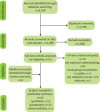Patient and public understanding of the concept of 'personalised medicine' in relation to cancer treatment: a systematic review
- PMID: 34888471
- PMCID: PMC8651337
- DOI: 10.7861/fhj.2021-0063
Patient and public understanding of the concept of 'personalised medicine' in relation to cancer treatment: a systematic review
Abstract
Personalised medicine (PM) is becoming increasingly integrated into standard clinical practice for treating numerous diseases, including cancer. Implementing PM into healthcare systems will only be successful with the acceptance and input of both patients' and public opinion. This review, therefore, aimed to identify both patients' and public understanding, and perceived benefits and concerns of PM in cancer treatment. A literature search was conducted using MEDLINE, EMBASE, PsycINFO and CINAHL databases. The eligibility criteria specified that papers must explore the public or patients' understanding of PM or pharmacogenomic (PGx) testing in relation to cancer treatment. Patients have a greater understanding of, and trust in, PM compared with members of the public, but often misunderstand how genomic testing in PM works. Key areas that can be targeted to inform future health literacy interventions include genetic literacy for the public and understanding of how PM testing and treatment works for patients.
Keywords: cancer; genomics; patients’ understanding; personalised medicine; public understanding.
© Royal College of Physicians 2021. All rights reserved.
Figures
References
-
- Department of Health and Social Care, Department for Business, Energy & Industrial Strategy, Office for Life Sciences, Lord Bethell of Romford . Genome UK: the future of healthcare. GOV.UK, 2020. [Accessed 29 October 2020]. www.gov.uk/government/publications/genome-uk-the-future-of-healthcare
-
- Holden C, Bignell L, Mukhopadhyay S, Jones C. The public perception of the facilitators and barriers to implementing personalized medicine: A systematic review. Per Med 2019;16:409–20. - PubMed
-
- Day S, Coombes RC, McGrath-Lone L, Schoenborn C, Ward H. Stratified, precision or personalised medicine? Cancer services in the ‘real world’ of a London hospital. Sociol Health Illn 2017;39:143–58. - PubMed
-
- Lerman C. BRCA1 testing in families with hereditary breast-ovarian cancer. JAMA 1996;275:1885. - PubMed
Publication types
LinkOut - more resources
Full Text Sources


